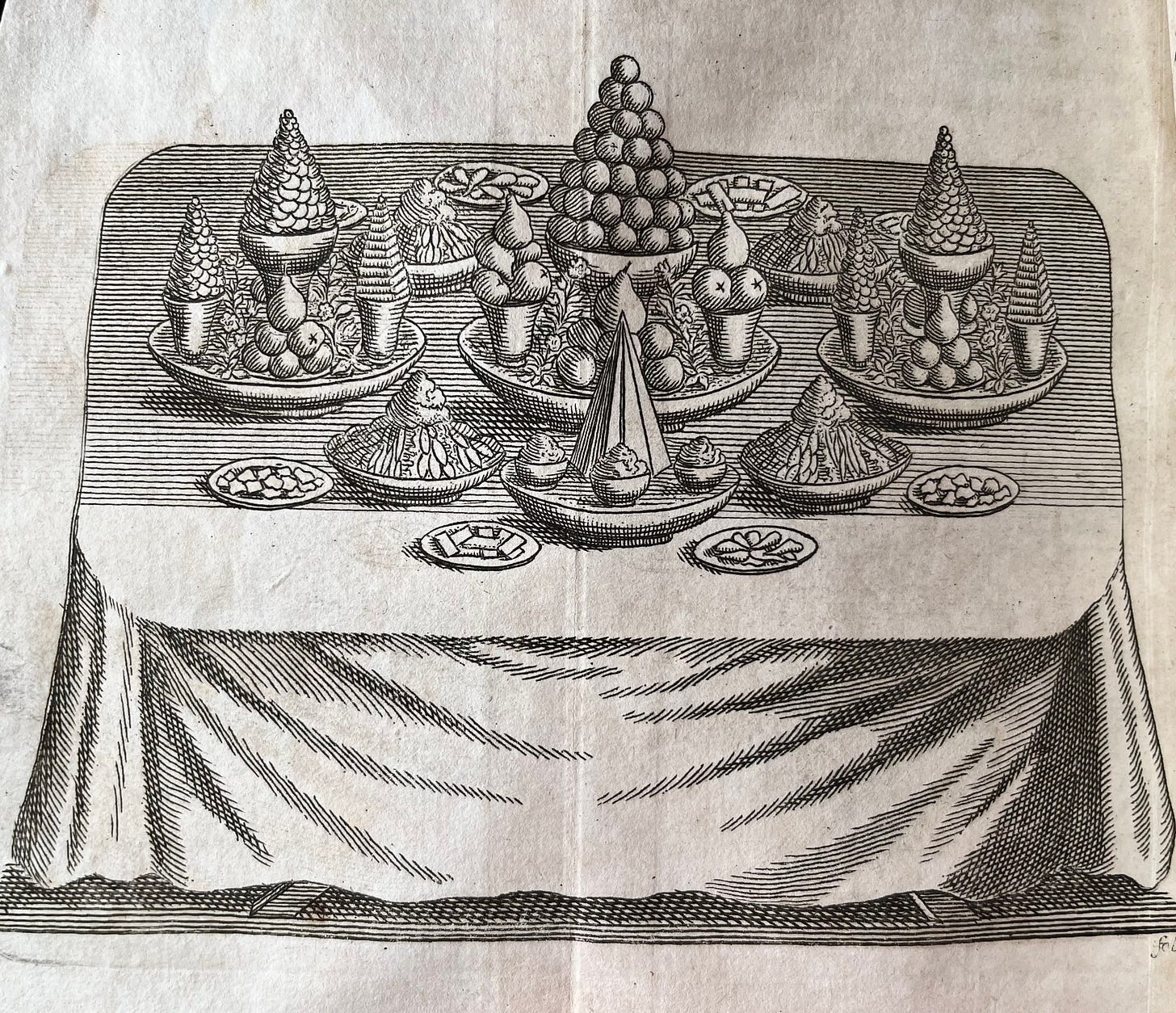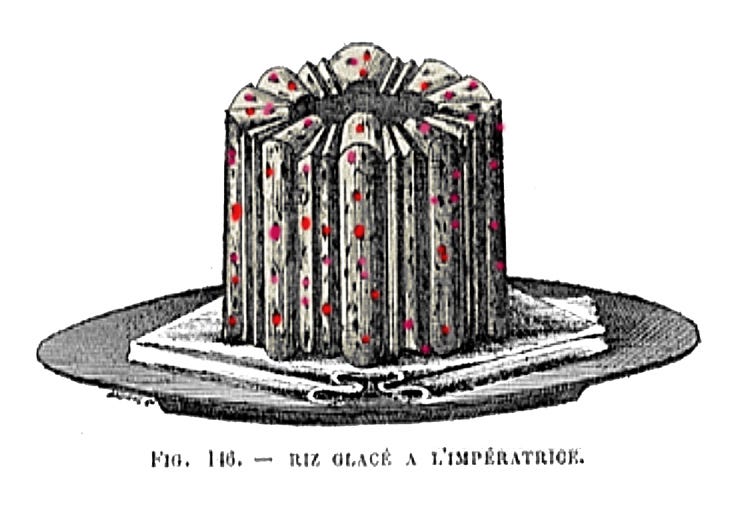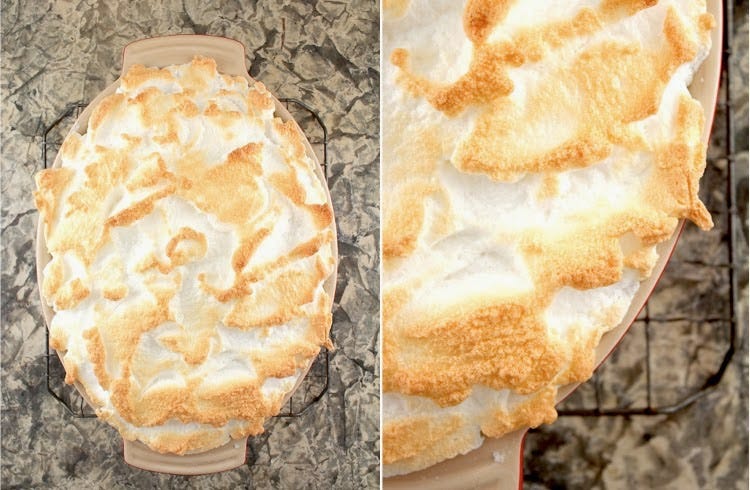The ambition of every good cook must be to make something very good with the fewest possible ingredients. - Urbain Dubois
So, the question is then, how do you take something humble, something ordinary, peasant fare or religious emblem, and turn it into something upscale, a delicacy for the upper classes or nobility? How do you move a dish out of the sickroom and the nursery and into the dining room?
How, in other words, do you sex it up?
I love how individual dishes, pastries, and ingredients transform over time and move through the social classes. It’s a perfect illustration of how societies and cultures change and evolve. We’ve seen it with veal blanquette, madeleines, onion soup, and financiers.
As I previously wrote in Part 1, riz au lait, French rice pudding, was long considered medicinal, a restorative, a digestive aid, given to invalids, children, and women considered “too thin” as a way to plump and protect the body. But as rice began to be cultivated in France and much more readily available, rice dishes were suddenly as accessible as dishes made with other grains such as millet, barley, farro, or spelt.
So how to lift up a simple dish to something more gastronomic? By adding costly, rich, or more exotic ingredients, flavorings available only to a more privileged population. By decorating it elaborately for maximum effect. And, of course, by naming the dish something a bit more captivating and intriguing, or something rather aristocratic.
Recipes began appearing in the famed cookbooks of the era in the early 19th century, cookbooks penned by the star chefs of the day who are known to be creating foods for the star personalities of the day. In 1806, André Viard, chef to such figures as Louis Philippe, Marquis and Count of Ségur, and statesman and nobleman Jean-Jacques-Régis de Cambacérès, writes what might be the first recipe for an elevated riz au lait in his cookbook Cuisinier Imperial. Pommes au riz or apples with rice is an elegant layering of apple compote, apricot marmalade, rice pudding prepared with cream, sugar, chopped lemon peel, the dessert topped with cédrat, citron or cedar fruit, or cherries and drizzled, if one so desires, with verjuice, an acidic juice or condiment made by pressing any of a variety of sour fruits such as unripe grapes, crabapples, or lemon, often flavored with herbs or spices.
9 years later, Antonin Carême, aptly nicknamed “the chef of kings and the king of chefs”, the man considered, even to this day, as the first “star chef”, Carême who cooked for Napoléon’s chief diplomat and Minister of Foreign Relations Talleyrand and his illustrious guests, wrote Le Pâtissier Royal Parisien ou Traité élémentaire et pratique de la pâtisserie ancienne et moderne (The royal Parisian pastrycook and confectioner: Basic and practical treatment of old and modern pastry) and included several elaborate recipes for variations on riz au lait, each molded and formed into a dome, crown, pyramid, or basket. The rice pudding was enriched with butter and egg yolks, perfumed with cedar fruit, sweet or bitter orange or lemon peel, layered with syrup-poached apples or apple jelly or apricot marmalade, ornamented with fresh or poached fruits and dried currants, as well as fruits disguised as other fruits and rice tinted in various colors, the whole often drenched in syrup and embellished with leaf-shaped nut cookies.
These molded gâteaux de riz quickly became synonymous with elegance and opulence, so much so that one was created in 1810 and named for Napoléon’s 2nd wife Marie-Louise, Empress of France, Queen of Italy, and Duchess of Parma. Or maybe it was created in 1860 and named for Eugénie de Montijo, Empress of France, wife of Emperor Napoléon III. While this little detail is disputed, what is known is that Riz à l'impératrice is a pretty revolutionary dessert, a frozen treat sumptuous in both ingredients and presentation. Riz au lait is blended with either Bavarian cream, crème anglaise, or whipping cream then processed into an ice cream-like frozen dessert, set in a charlotte or other fancy mold, then decorated with candied fruits macerated in kirsch, maraschino, or other liqueur.
Le riz et les abricots à la Condé, was named after the illustrious house of Condé, princes and faithful servants of the royals, again pairing riz au lait with apricots. Rice pudding enriched with egg yolks and butter and perfumed with vanilla, lemon zest, and orange flower water, is molded into a tiered pyramid, candied fruits are then placed on the tiers in alternating colors and decorated with candied angelica and almonds. The pyramid is then bathed in an apricot and eau-de-vie syrup and served with an apricot sauce. Small, round or oval fried croquettes made with some of the rice pudding - another new but quickly popular riz au lait preparation - were often placed on the molded riz à la Condé as well.
Le riz à la Dauphine was a popular 19th century classic gâteau de riz, a molded dessert made with enriched riz au lait infused with cédrat or other citrus zests and vanilla, but also flavored with crushed bitter macarons, prepared with the core seed of the bitter or wild almond.
By 1868 and Urbain Dubois’ La Cuisine Classique, we’re seeing a repetition or variation of those grand recipes in more and more cookbooks, indicating the establishment of these now popular desserts in the French culinary repertoire and a desire to simplify them for the more modern bourgeois home, while retaining their fashionable, sumptuous difference from the humble, simple riz au lait. Dubois takes Carême’s extravagant creation and streamlines it to a vanilla-infused rice pudding surrounded by pommes meringuées, cooked apples piled high with lightly caramelized meringue, the whole coated with apricot sauce.
My own version is an easy, slightly more homey dessert, a layer of creamy vanilla-infused riz au lait, a layer of cooked apple compote scented with cognac, and then topped with meringue which is slightly caramelized in the oven. The rice pudding can also be flavored with lemon zest or orange flower water if you like, and the cognac in the apples replaced with rum or even maple syrup. It takes a bit of time and organization to prepare the 3 layers but it is extremely simple and oh so worth the effort.
Meringue-Topped Rice Pudding with Apples
This French classic pairing creamy rice pudding, tender caramelized apples, and meringue is both sumptuous and pure comfort.
Note: There are 3 parts to this recipe: rice pudding, caramelized apples, meringue: the ingredients are in the order used; read the recipe completely to understand, as some ingredients are used in more than 1 part and so repeated in the list, and each component might be broken up in the recipe while another part is begun or prepared before another component is completed.
7 ounces (200 grams) round rice for puddings/risotto
3 ¼ cups (750 ml) milk
1 teaspoon sugar
1/8 teaspoon salt
3 medium apples
2 tablespoons (45 grams) unsalted butter
1 tablespoon sugar
2 tablespoons cognac (can be replaced by amber rum, whiskey or ½ tsp vanilla)
2 large egg yolks
4 tablespoons (60 grams) sugar
½ teaspoon vanilla
3 large egg whites
Small pinch salt
3 tablespoons (45 grams) sugar
Butter a large, shallow baking dish; I used a 10 ½ x 8 x 2 – inch oval.
Place the rice in a fine sieve and rinse under cold running until the water runs clear. Drain well.
Bring the milk just to the boil, add a teaspoon of sugar, the pinch salt, and the drained rice, stirring. Bring back to the boil, lower to a very low simmer and cook, stirring when needed (by the halfway point I was stirring almost constantly), for about 30 – 35 minutes or until the rice has absorbed all of the milk, the rice is very tender and the pudding is creamy.
While the rice is cooking in the milk, peel and core the apples then slice them into thin wedges. Melt the butter in a large skillet or pan, add the apples, tossing to coat with the butter, then cook until the apples are tender, 10 minutes. 1 - 2 minute before the apples are done, “stir in 1 tablespoon sugar and 2 tablespoons cognac. Continue cooking for the last couple of minutes as the sugar dissolves and the alcohol from the cognac cooks off. Remove from the heat.
Preheat the oven to 400°F (200°C). Move a rack to the slot one above the center of the oven.
When the rice is done, remove from the heat and allow to cool for only a couple of minutes.
Whisk the yolks in a heatproof bowl and then whisk in a large spoonful of the hot rice, then another, then another, allowing the yolks to heat gradually as you whisk. Once about half the hot rice has been added to the yolks, scrape the whole thing back into the remaining rice in the pot, stirring to blend.
Whisk in the 4 tablespoons sugar and the vanilla.
Spread the rice pudding in the buttered baking dish then top with an even layer of cooked apples.
Place the whites in a bowl with a pinch of salt. Beat on low speed for 1 minute then increase to high speed. Beat until the whites are no longer foamy and soft peaks are starting to appear; continue beating while you gradually add the 3 tablespoons of sugar. Beat until glossy and stiff peaks hold. The whites should feel dense & thick when touched. Lightly spread the whites evenly over the rice & apples all the way to the edges.
Slide the baking dish into the preheated oven and bake for 5 – 6 minutes to color “the tops of the whites.
Thank you for subscribing to my Substack, Life’s a Feast by Jamie Schler, where I share my (mostly French) recipes, my hotel and my jams, my projects, and the stories of my life. You can support my work by sharing the link to my Substack with your friends, family, and your social media followers. I’m so glad that you’re here.









OMFG
Looks delicious, and straightforward in execution, but WHAT a pretty result with that golden meringue! I look forward to fixing this as I have everything needed.